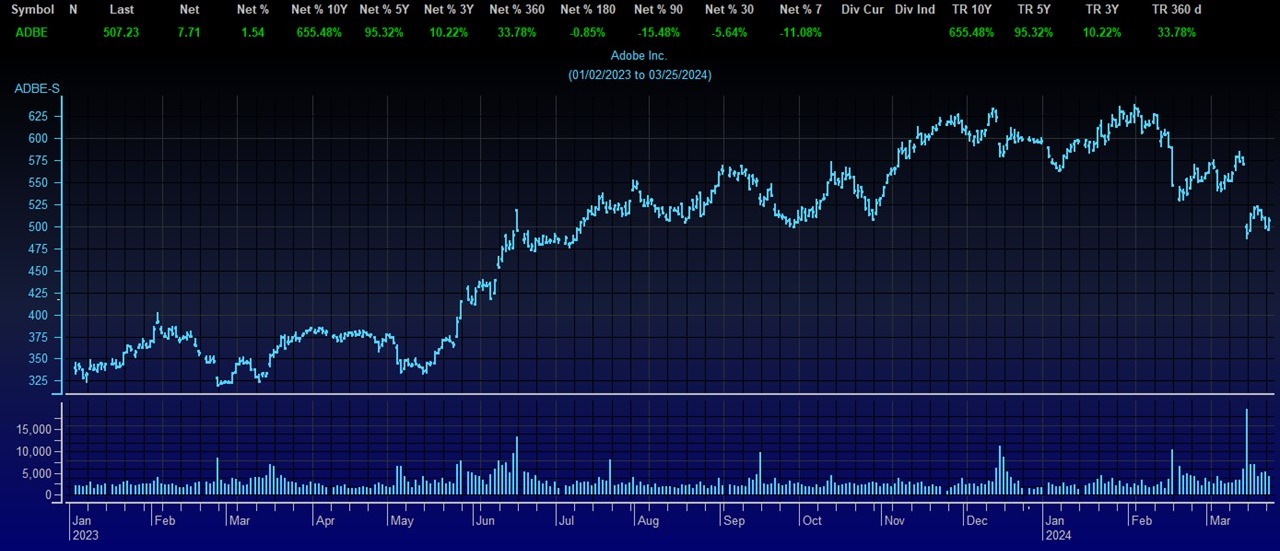Written by: Carly Rothbort
Adobe (ADBE) reported its first quarter 2024 earnings on March 13th. The company reported $5.18 billion in revenue, coming in slightly above analyst expectations of $5.15 billion. In addition to revenue, the company reported earnings per share (EPS) of $4.48, also beating analyst estimates of $4.38. However, they issued revenue guidance for the second quarter of $5.28 billion, just below analyst estimates of $5.31 billion. While the company met and exceeded expectations for the first quarter, the company gave soft guidance for the future. As a result, ADBE stock fell by about 9% in the following trading day after reporting results.
Digging deeper into Adobe and its history, products, and competitive marketplace:
ADBE is continually changing, improving, and inventing. You ask any regular, expert user and they will tell you there is still so much they have to learn, and the use of Adobe is endless. I am a regular Adobe user. If you are familiar with my background, you already know I started as a graphic designer and was even an Adobe student representative in college when they were introducing the new Adobe Creative Cloud. So, to say the least, I have seen Adobe grow from single products like Adobe Photoshop and Adobe Illustrator, to their Creative Cloud subscription, and now to their Document Cloud, Experience Cloud, and generative AI (artificial intelligence) integrations including Firefly, debuted earlier this month. They have historically kept up with the times, but can they beat the ever-evolving pressure and competition from emerging products like Canva, Microsoft (MSFT), Google (GOOG), and Salesforce (CRM)? In an AI-driven world, ADBE has something to prove; that they can be part of the next generation of software providers.
Was the stock price decline justified?
Last year the company took a hit with a 1 billion dollar termination charge for its failed $20 billion FIGMA merger after regulatory issues. However, the market responded favorably to that after they originally responded negatively to the merger announcement. ADBE’s current focus is growing customer subscriptions, monetization, and generative AI. The more valuable ADBE makes its product, the more it can increase its subscriptions and revenue. Here is a deeper dive into investors' outlook of ADBE post Figma scrap. While they exceeded last quarter's expectations and experienced a dip in their stock, they are experiencing strong momentum across their Cloud products, and I predict to see some continued growth.
LakeView has owned ADBE in our consumer portfolio since January 2023 and originally bought it at a price of approximately $359. The stock now stands at just above $500, down approximately 27% from its peak price. So, that begs the question, what do we plan on doing with ADBE stock? Add, sell, or hold? That depends entirely on our valuation of the company’s stock, so let’s break it down.
From fiscal year 2023 when the company earned $14.81 per share to fiscal year 2025 when it is expected to earn $18.75 per share, that equates to about a 27% two-year increase. That implies a 13% annual growth rate. With that said, with a current price just above $500, the stock is valued at approximately 30 times current year earnings. It is selling at a 2.3 PEG ratio of price-earnings to growth for the current year. The stock is valued at 27 times forward earnings. Which means the stock is selling at a 2.0 forward PEG ratio.
Given the company's tepid guidance and analysts' lowering of expectations, the stock seems priced for perfection, meaning there is no room for error. With all things considered, we are a better seller of ADBE and will look for a bounce to do so. Technically speaking, the damage has been done to the stock and has a gap to fill to about $550. As of right now, we are holding the stock and reevaluating once the stock gets back to around $550 or the next quarter's reporting.
We are giving ADBE the benefit of the doubt by sticking with the stock and allowing them to prove they can overcome the deficits from the most recently reported quarter.

Related: Relax, It’s Just a Market Pull-Back


